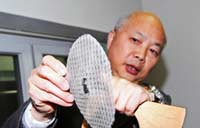Clearing the air
He tells China Daily: "We thought it would be interesting to use smog as a design component."
The vacuum would be a mass of underground copper coils that generates an electrostatic charge that pulls smog particles from the sky.
"It's a similar principle to if you have a statically charged balloon that attracts your hair," Roosegaarde tells Dezeen.
"If you apply that to smog to create fields of static electricity of ions, which literally attract or magnetize the smog so it drops down so you can clean it, (it's) like an electronic vacuum cleaner."
It would operate according to principles similar to those of household air purifiers' electrostatic precipitators but would function on a mass scale in public spaces.
"The idea sounds like it uses the same principle as electrostatic particle collectors, which are common in China's thermal power plants," Chinese Research Academy of Environmental Sciences vice-president Chai Fahe says.
"It's clever but may not be a realistic solution to Beijing's air pollution. How much could it really affect smog? Do we turn the capital into an electromagnetic field? The electricity required to power the device may produce more pollution than it absorbs."
Roosegaarde claims the smog that'd be produced by the electricity that runs the device would be "thousands" of times less than the amount it cleans.
"This is one of the huge advantages of our technique - the low energy consumption - especially compared to competitors," says Lia van de Vorle, CEO of the machine's manufacturer and the technology's patent owner ENS Europe.
The prototype developed with University of Delft scientists punched a 1-square-meter hole in a 25-square-meter smog-choked room within seconds. A video of the experiment is online.


















